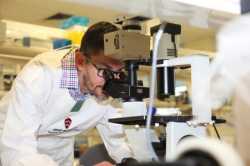Author Interviews, Heart Disease, Technology / 26.06.2015
Electromagnetic Interference Between Smart Phones and Cardiac Devices Rare But Possible
 MedicalResearch.com Interview with:
Dr. Carsten Lennerz
Deutsches Herzzentrum
München
Medical Research: What is the background for this study? What are the main findings?
Response: The number of cardiovascular implantable electronic devices (CIEDs) is increasing. Worldwide more than 4 million people rely on an implanted pacemaker (PM) or implantable cardioverter defibrillator ICD. Sensing intrinsic cardiac electrical activity is the core principle of all CIED devices, however in case of electromagnetic interference (EMI) exogenous electric and magnetic fields can be picked up by the sensing circuit and mistakenly interpreted as a cardiac signal by the CIED. PM can respond to EMI with pacing-inhibition, leading to bradycardia or asystole and resulting in syncope. In ICDs EMI may be detected as a life threatening ventricular arrhythmia with the subsequent delivery of inappropriate shocks.
Early studies on EMI, run more than 10 years ago, have identified mobile phones as a source of EMI with pacemakers. Based on these pacemaker studies the CIED manufacturer and the regulatory authorities (e.g. Food and Drug Administration [FDA]) currently recommend a safety distance, i.e. hold the phone to the contra-lateral ear and avoid placing a turned-on phone next to the generator pocket.
In the meantime telecommunication and the CIED techniques have dramatically evolved. The classic mobile phone has been replaced by modern smartphones, furthermore the network standards have changed from GSM to UMTS (3G) and LTE (4G). New cardiac devices are now in use including more devices for cardiac resynchronisation therapy (CRT) or for the protection from sudden cardiac death (ICD); some of them are even compatible for MRI diagnostics.
With the use of a hemertic titanium shell, new filtering properties of the feed-throughs, sense amplifiers and noise protection algorhythms as well as the predominant use of bipolar leads the CIED may be better shielded against external influences and adverse effects of EMI.
In light of the above, the purpose of our study was to evaluate if previous precautions recommended to cardiovascular implantable electronic devices recipients are still up-to-date or if they can be abandoned. By today there are neither studies focusing on EMI between modern smartphones and modern CIEDs nor on newer mobile network standards (UMTS or LTE).
In a cross-sectional study we enrolled 308 patients and exposed them to the electromagnetic field of three smartphones (Samsung Galaxy 3, Nokia Lumia, HTC One XL) by placing the handhelds directly over the pulse generator. Installing an own base mobile network station we ensured that each smartphone went through a standardized protocol that included the entire calling process (connecting, ringing, talking), the handovers between all current network standards (GSM, UMTS, LTE where applicable) and operation at maximal transmission power.
More than 3.400 tests on electromagnetic interference were performed. One out of 308 patients (0.3%) was repeatedly affected by EMI caused by smartphones. The patient’s MRI compatible CRT-defibrillator malfunctioned with short-term ventricular and atrial oversensing when exposed to Nokia or HTC smartphones operating at GSM and UMTS. (more…)
MedicalResearch.com Interview with:
Dr. Carsten Lennerz
Deutsches Herzzentrum
München
Medical Research: What is the background for this study? What are the main findings?
Response: The number of cardiovascular implantable electronic devices (CIEDs) is increasing. Worldwide more than 4 million people rely on an implanted pacemaker (PM) or implantable cardioverter defibrillator ICD. Sensing intrinsic cardiac electrical activity is the core principle of all CIED devices, however in case of electromagnetic interference (EMI) exogenous electric and magnetic fields can be picked up by the sensing circuit and mistakenly interpreted as a cardiac signal by the CIED. PM can respond to EMI with pacing-inhibition, leading to bradycardia or asystole and resulting in syncope. In ICDs EMI may be detected as a life threatening ventricular arrhythmia with the subsequent delivery of inappropriate shocks.
Early studies on EMI, run more than 10 years ago, have identified mobile phones as a source of EMI with pacemakers. Based on these pacemaker studies the CIED manufacturer and the regulatory authorities (e.g. Food and Drug Administration [FDA]) currently recommend a safety distance, i.e. hold the phone to the contra-lateral ear and avoid placing a turned-on phone next to the generator pocket.
In the meantime telecommunication and the CIED techniques have dramatically evolved. The classic mobile phone has been replaced by modern smartphones, furthermore the network standards have changed from GSM to UMTS (3G) and LTE (4G). New cardiac devices are now in use including more devices for cardiac resynchronisation therapy (CRT) or for the protection from sudden cardiac death (ICD); some of them are even compatible for MRI diagnostics.
With the use of a hemertic titanium shell, new filtering properties of the feed-throughs, sense amplifiers and noise protection algorhythms as well as the predominant use of bipolar leads the CIED may be better shielded against external influences and adverse effects of EMI.
In light of the above, the purpose of our study was to evaluate if previous precautions recommended to cardiovascular implantable electronic devices recipients are still up-to-date or if they can be abandoned. By today there are neither studies focusing on EMI between modern smartphones and modern CIEDs nor on newer mobile network standards (UMTS or LTE).
In a cross-sectional study we enrolled 308 patients and exposed them to the electromagnetic field of three smartphones (Samsung Galaxy 3, Nokia Lumia, HTC One XL) by placing the handhelds directly over the pulse generator. Installing an own base mobile network station we ensured that each smartphone went through a standardized protocol that included the entire calling process (connecting, ringing, talking), the handovers between all current network standards (GSM, UMTS, LTE where applicable) and operation at maximal transmission power.
More than 3.400 tests on electromagnetic interference were performed. One out of 308 patients (0.3%) was repeatedly affected by EMI caused by smartphones. The patient’s MRI compatible CRT-defibrillator malfunctioned with short-term ventricular and atrial oversensing when exposed to Nokia or HTC smartphones operating at GSM and UMTS. (more…)















